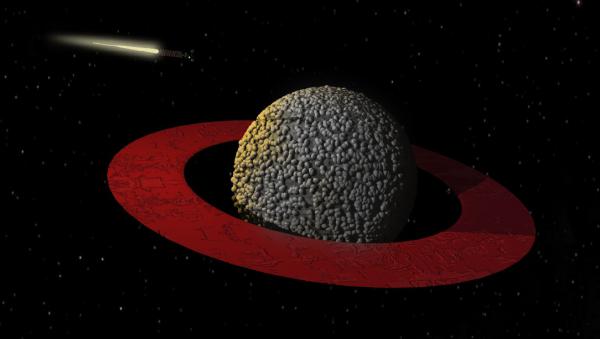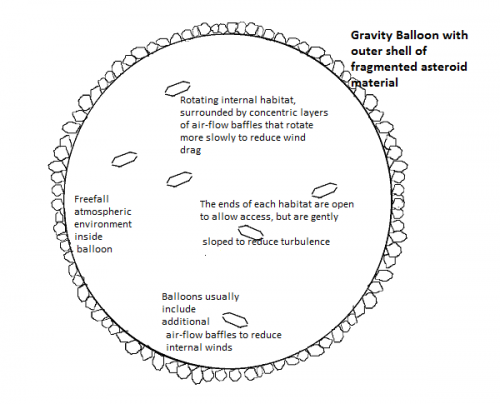BY LETTER
Gravity Balloons
Technology > Application > Envirotech
Technology > Application > Infrastructure
Technology > Application > Megascale Engineering
Technology > Application > Infrastructure
Technology > Application > Megascale Engineering
Balloon-like habitats in space which use asteroid material to counter the pressure on the surface of the balloon. | |
 Image from Steve Bowers | |
| A gravity balloon covered in asteroid chunks, with a dual-purpose radiator/ photovoltaic ring to manage energy flows in the habitat. | |
The atmosphere inside large microgravity habitats exerts a very large pressure on the outside shell. Pressure of this sort can be contained using hyperstrong materials such as buckyfibre or diamondoid, but even these materials have limits. Alternately (or additionally) the pressure can be contained by the minimal gravity of the habitat itself, acting on a massive shell. This shell can be made quite simply by using asteroid material as ballast and has a minimal strength requirement.
A gravity balloon can be constructed from an asteroid by excavating a cave at the centre; if the asteroid is larger than 37 kilometres in diameter, the weight of the rock will be enough to counterbalance the air pressure from a small, lined spherical cavern at the centre. Larger asteroids can support larger spherical caverns, although the asteroid will need to be completely disassembled to form a skin over the outside of the balloon.
Alternately a flexible liner can be gradually inflated in space, and then rocks are added around it while more air is added. Initially, its pressure can be quite low. But once the rocks are added, the strength of the balloon will limit how large the rocks can be without causing an avalanche of rocks which would destroy the entire construction.
Gravity balloons can also be used to store large quantities of volatiles cheaply, for instance at gas and propellant depots. Since these can be stored at lower pressures, gravity balloons can be built using asteroid rock that comes from smaller asteroids that can be found throughout most solar systems. Since the requirements on the balloon material are light, they can be sent up in modest launch vehicles, but still store immense amounts of gas.
 Image from Steve Bowers | |
| Often a gravity balloon will have a second, outer skin to retain the asteroid material, which may support additional infrastructure such as solar power collectors and radiator systems. | |
Many gravity balloons maintain a microgravity environment throughout, with smaller micro-gee constructions inside inhabited by space-adapted humans and other microgravity clades, or modosophonts who have been temporarily adapted for freefall. Transport within these microgravity balloons is often provided by pneumatic tubes of various kinds.
Other gravity balloons include rotating space habitats of various sizes, usually quite small, which are surrounded by concentric layers of air-flow dividers that reduce the wind speed around the rotating habitat to negligible amounts. Larger gravity balloons are divided into numerous compartments by similar airflow dividers to reduce internal winds.
Light and power for the gravity balloon-type habitat can be produced by internal fusion sources known as 'hotpoints'; these provide heat and light for these and similar habitats, including those located in the outermost reaches of a planetary system or in interstellar space. Other habitats use rings or arrays of mirrors or solar power collectors. In common with other types of habitat gravity balloons also use radiators of various designs to eliminate waste heat whenever necessary.
Most large Freespheres, freefall atmospheric habitats, even those with with outer skins of diamondoid and other hyperstrong material use gravitational space balloon technology to reduce the stress on their outermost shells. The largest balloons of all, the Ederworlds, have massive shells of iron to produce counterpressure.
Related Articles
- Artificial Worlds
- Ederworlds
- Freesphere
- Gravity - Text by M. Alan Kazlev
One of the fundamental physical forces of nature, it binds objects together on the macroscopic scale. Mass produces a gravitational force, which attracts all other masses. The more massive an object, the stronger the gravitational force. The late Industrial/early Atomic Age physicist Einstein showed in his theory of general relativity that gravity can be explained in terms of local curvature of space-time. - Microgravity - Text by M. Alan Kazlev
A state in which gravity is reduced to virtually negligible levels. For example, when an object is in free fall, it experiences microgravity. It is deleterious to baseline physiology, but space-adapted tweaks can survive a microgravity environment indefinitely. - Microgravity Space Habitats
- Rotating Space Habitats
Appears in Topics
Development Notes
Text by Steve Bowers, AlanSE
Based on material by AlanSE
Initially published on 29 December 2014.
For much more information on Gravitational Space Balloons see AlanSE's blog and also this article at SciFi ideas.
Based on material by AlanSE
Initially published on 29 December 2014.
For much more information on Gravitational Space Balloons see AlanSE's blog and also this article at SciFi ideas.






